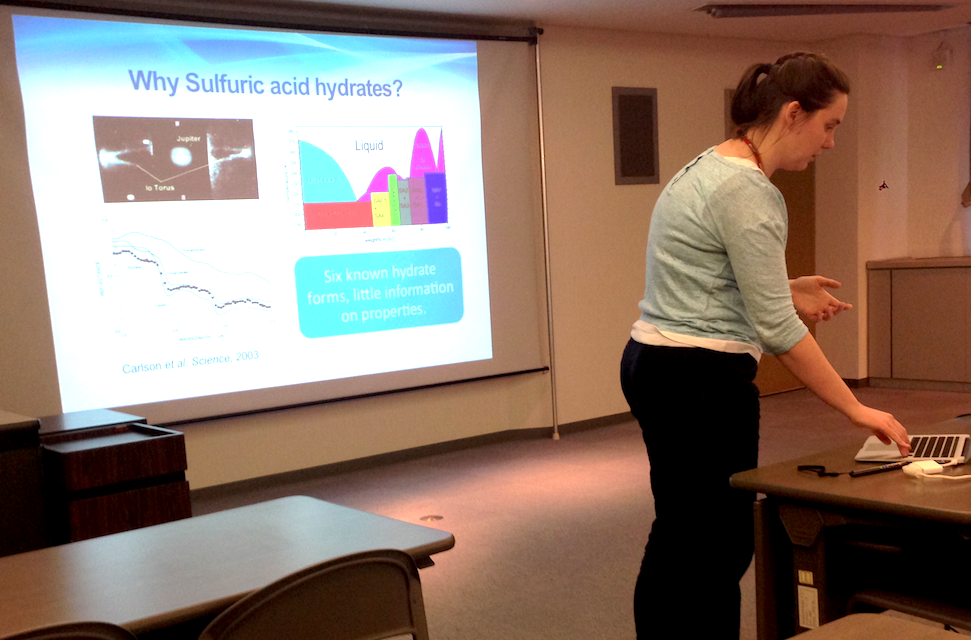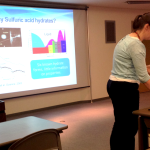
What to expect on the surfaces of the more distant planets is a hard question to answer. Fortunately, we have scientists working on this problem.
At our institute, we just had the pleasure of hosting a talk by Dr. Maynard-Casely, whose mission is to add a certain amount of evidence-based level-headedness to the discussions. I will do my best to summarize the contents of her excellent and engaging talk.
 As we are extremely limited in our capacity to visit the surfaces of other planets and moons, determining their makeup is necessarily challenging. There is a group of scientists working on figuring out what they could possibly consist of, and how that the most likely candidates may be inferred from the limited measurements available.
As we are extremely limited in our capacity to visit the surfaces of other planets and moons, determining their makeup is necessarily challenging. There is a group of scientists working on figuring out what they could possibly consist of, and how that the most likely candidates may be inferred from the limited measurements available.
Dr. Helen Maynard-Casely is focusing on what possible structures can exist on the surfaces of the Galilean moons of Jupiter. For this, she mainly uses synchrotron X-ray and neutron diffraction.
Compositional information of the moons is largely gleaned from spectroscopic information sent back from (rather dated) spacecraft, and from meteorites from the approximate region. Armed with this information, and knowledge about the pressures and temperatures, the investigation begins.
We know that the surface of the Galilean moons are dominated by water ice, but spectroscopy shows a large fraction of non-water material as well. From Helen’s perspective, sulfuric acid hydrates are likely candidate materials expected on the surfaces of ice moons such as Europa, Ganymede and Callisto. However, information on these materials’ properties is rather limited, preventing a thorough understanding of the likely surface and sub-surface properties.
Using a good deal of skepticism and common sense, and copious (mostly Australian) X-rays [1] and neutrons [2], Helen started investigating possible structures of sulfuric acid hydrates under the appropriate environmental conditions. This has led to her discovery of an exciting new structural form of water-rich sulfuric acid hydrates [3], better structures for existing forms [4], and led to detailed charting of the phase diagram of this fundamental binary system [5].
Interestingly, the phase diagram in particular can also shed light on the thermal history of the materials. Therefore, with the arrival of new spacecraft, new spectroscopic information will allow us to glean insight into the internal geological processes of the moons. These moons, rather than the planets they orbit, are becoming ever more fascinating the more we look at them.
I very much advise people to book Helen for a talk, for a detailed insight in the sciences that revolve around planets.
References
[1] Wallwork, K.S., Kennedy B. J. and Wang, D. (2007) “The high resolution powder diffraction beamline for the Australian Synchrotron” AIP Conference Proceedings, 879: p. 879-882.
[2] Liss, K.D., et al. (2006) “Echidna – the new high-resolution powder diffractometer being built at OPAL” Physica B-Condensed Matter, 385-86: p. 1010-1012.
[3] Maynard-Casely, H.E., Wallwork,K.S. and Avdeev M. (2013) “A new material for the icy Galilean moons: The structure of sulfuric acid hexahydrate.” Journal of Geophysical Research: Planets, 118(9): p. 1895-1902
[4] Maynard-Casely, H.E., Brand, H.E.A. and Wallwork K.S. (2012) “The structure and thermal expansion of sulfuric acid octahydrate”. Journal of Applied Crystallography, 45: p. 1198-1207.
Maynard-Casely, H.E., Brand, H.E.A. and Wallwork K.S. (2014) “The water-rich H2SO4/H2O phase diagram, a potential marker of thermal history on Jupiter’s icy moons” Icarus 238, 59-65.

Leave a Reply